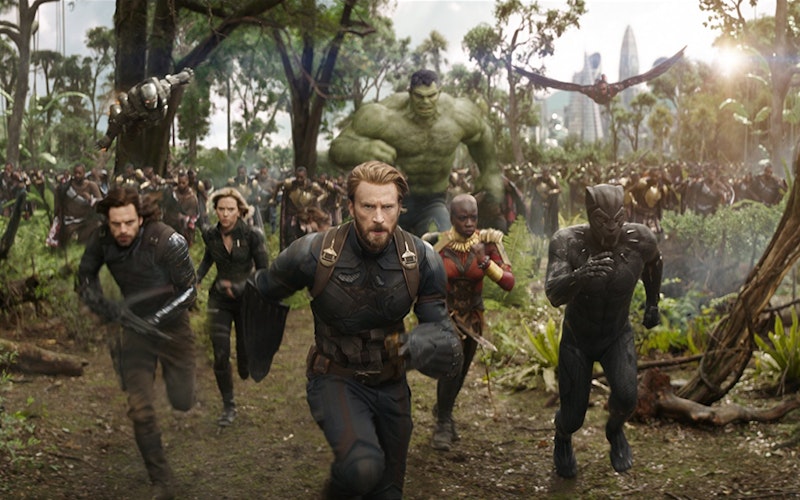
Movies
Christ Figures, Assemble! Examining Sacrifice in Avengers: Infinity War
It’s difficult to judge a two-part movie based on the first half alone, but Avengers: Infinity War—which sets up dominoes that will fall in next year’s Avengers movie—still gives us a lot to work with. A lot of plot, anyway. Despite its length, most of its many stars have limited screen time. There’s plenty of planet-jumping and precious little character development. Instead, the film’s emotional work is done by the jokes that break up the dark tone, and by the signature shots of assembled superheroes.
The slow-motion sequence of an entire team running into battle is the cinematic equivalent of a splash page. In the world of comics, these pages are used for dramatic effect, punctuating a clash between titans and making the action seem larger than life—or at least larger than the panels that dictate the traditional comic-book layout. Infinity War, directed by brothers Joe and Anthony Russo, uses its own splash shots liberally, an artistic choice that makes sense because of the sheer number of heroes populating its scenes. But the most effective splash shots in the movie are not the ones of the Avengers on the attack; they’re the ones of heroes sacrificing themselves for the greater good.
The concept of sacrifice is everywhere in superhero movies, which are particularly susceptible to portraying their characters as Christ figures. True to form, Infinity War is stuffed full of sacrifices, almost too many to count. (Spoilers ahead.) Thor (Chris Hemsworth) puts his body on the line in order to create a much-needed weapon. Tony Stark (Robert Downey Jr.) leaves his fiance (Gwyneth Paltrow) on Earth in order to pursue an alien threat and rescue a colleague. Doctor Strange (Benedict Cumberbatch) gives up a precious artifact to save the life of a friend. T’Challa (Chadwick Boseman) risks the safety of his country by opening a gap in its defenses, rendering his people vulnerable to attack but buying more time in the fight against the film’s villain, Thanos.
Thanos himself (Josh Brolin) is devoted to the concept of sacrifice, albeit a twisted version of it. His goal is to wipe out half the beings in the overpopulated universe in order to “bring balance.” Thanos also sacrifices his adopted daughter Gamora (Zoe Saldana) so that he can attain one of six Infinity Stones. Possessing all six would give Thanos the power to achieve his goal. The scene in which Thanos gives up Gamora mirrors Abraham’s sacrifice of Isaac, but it’s a dark mirror that offers a warped reflection. Instead of a sacrifice in devotion to God, Thanos’ sacrifice is for selfish and malicious ends. Instead of a ram taking Gamora’s place at the last minute, the sacrifice goes through. In a double irony, Gamora had already asked Peter Quill (Chris Pratt) to kill her should she end up in Thanos’ hands, in order to protect the location of the Infinity Stone. Quill proves unable to fulfill her request, and Gamora dies for the stone anyway.
The most effective splash shots are those of heroes sacrificing themselves for the greater good.
Of all the sacrificially coded splash shots in the movie, the one featuring Wanda/Scarlet Witch (Elizabeth Olsen) and Vision (Paul Bettany) comes closer to the Christian understanding of Jesus’ sacrifice and atonement. Vision bears an Infinity Stone in his forehead; it’s an integral part of who he is and it’s what gives him his power. It’s also the last stone Thanos needs. Wanda is the only person who can destroy the stone and prevent Thanos from getting his hands on it—but by destroying the stone, she would kill Vision, whom she has come to love. In a film full of crowded frames, the climactic moment involving Vision and Wanda takes place in open space, as we watch one of them give up an essential part of his being—dying in the process—while the other gives up her beloved.
As striking as the scene is, it still does not fully encompass the Christian understanding of atonement, in which Christ’s work on the cross atoned for the sins of the world. Here, as in much of Infinity War, sacrifice is a preventative, an attempt to halt something bad from happening. This is a narrow understanding of sacrifice: giving up something precious to get ahead in a fight. As such, the sacrifices made in the movie are all akin to moves on a chess board. They assign value to different players and give them up when necessary to accomplish a goal. There’s a grand calculus at play, balancing one life (Vision’s, Gamora’s, or whoever else is in danger at that very moment) against the lives of half the universe. It’s a game with no wins, only losses, even for the players who come out on top.
At its best, Avengers: Infinity War brings to mind John 15:13: “Greater love has no one than this: to lay down one's life for one's friends.” It also reminds me of Dietrich Bonhoeffer’s claim that “when Christ calls a man, he bids him come and die.” There is plenty of voluntary sacrificial love in Infinity War. Yet it still falls short of the ultimate sacrifice and atonement in the salvation narrative, in which Christ’s death was not a preventative of oncoming danger, but a cure for an already broken world and a promise that the world will be made new again.
The world will be redeemed. God will be glorified. There will be no more pain. This we know. We don’t know the fate of the Avengers. We’ll have to wait another year in order to see if all the sacrifices made in Infinity War were made in vain, or if the end is not the end, but just a continuation of the story.
Topics: Movies